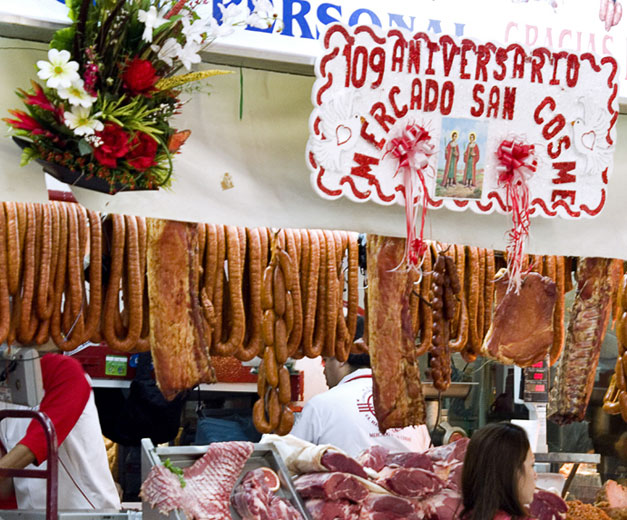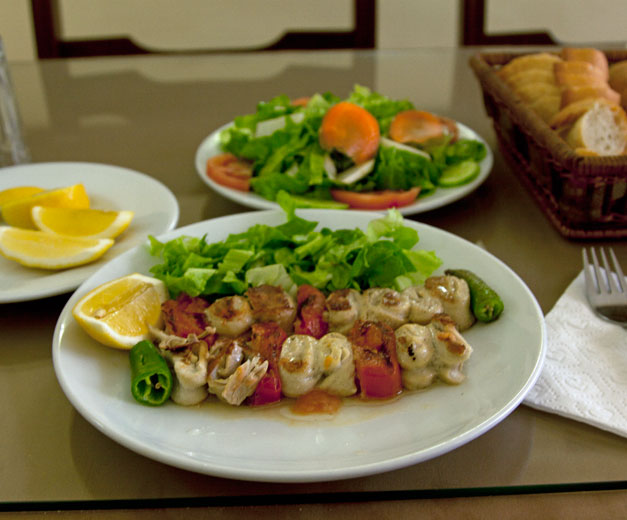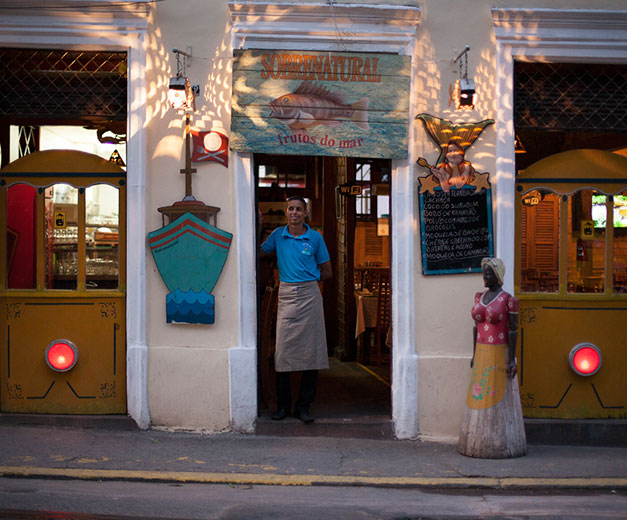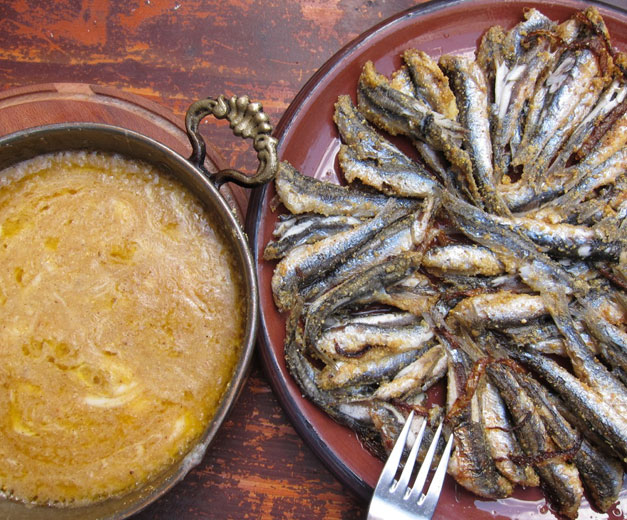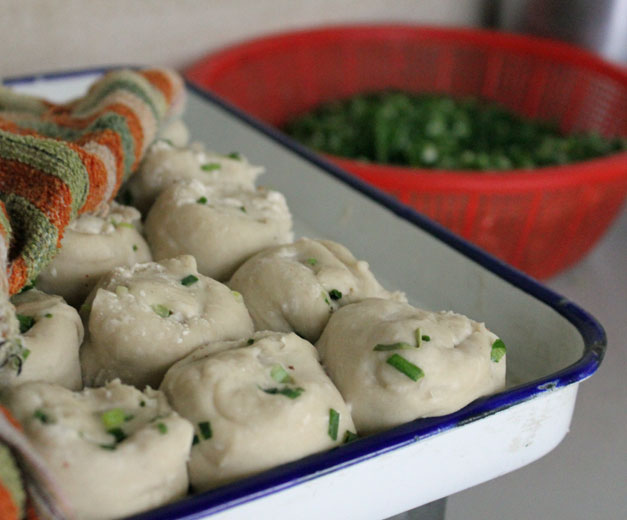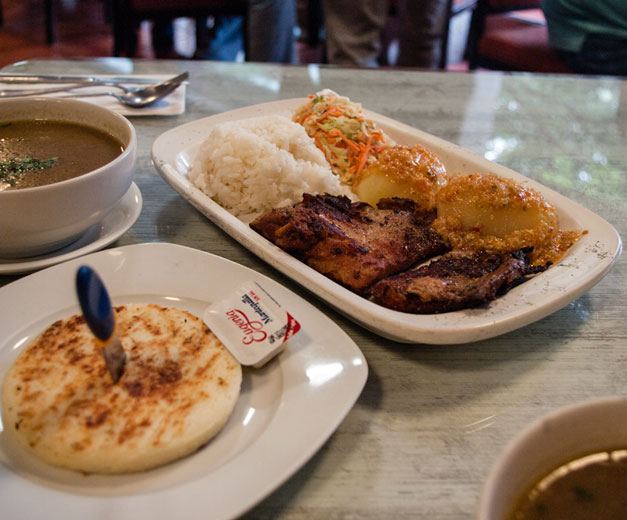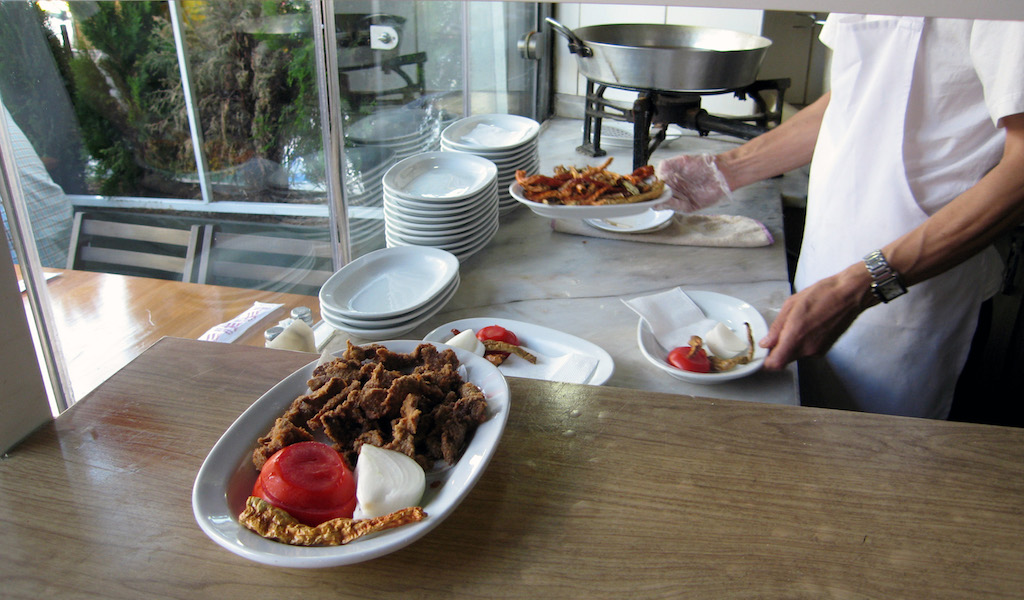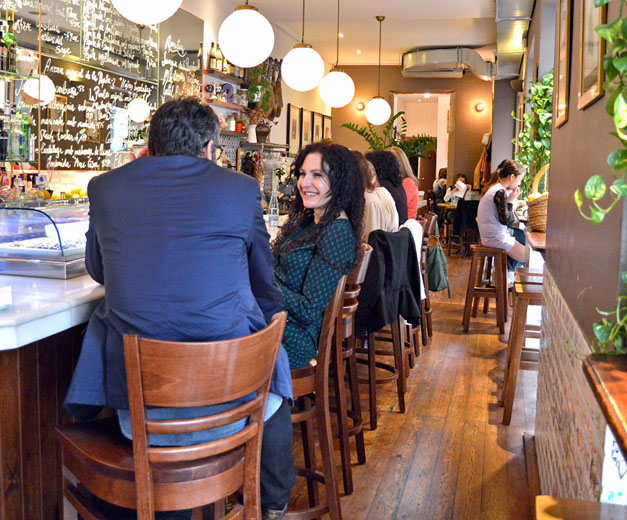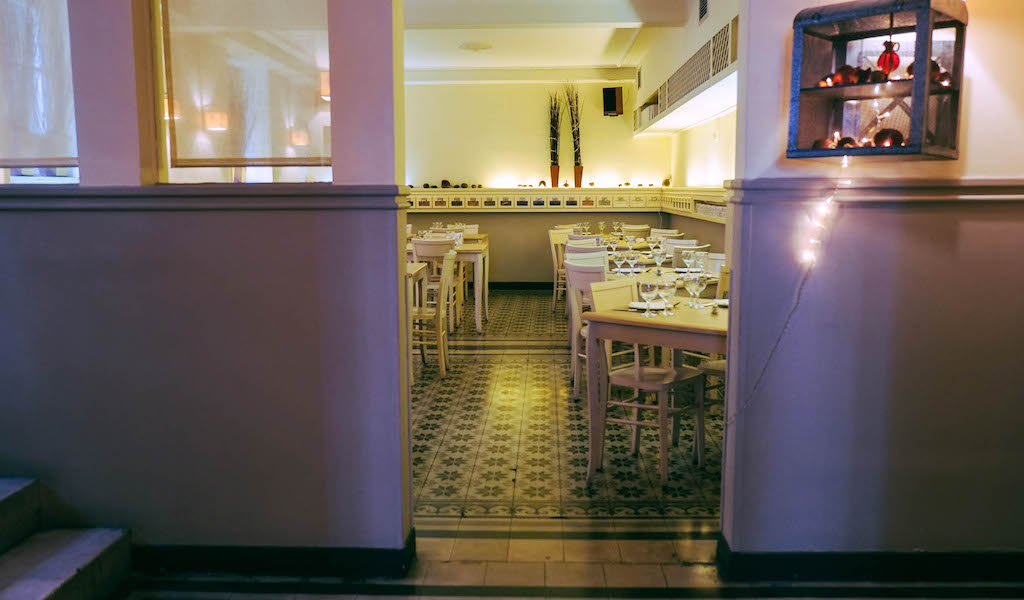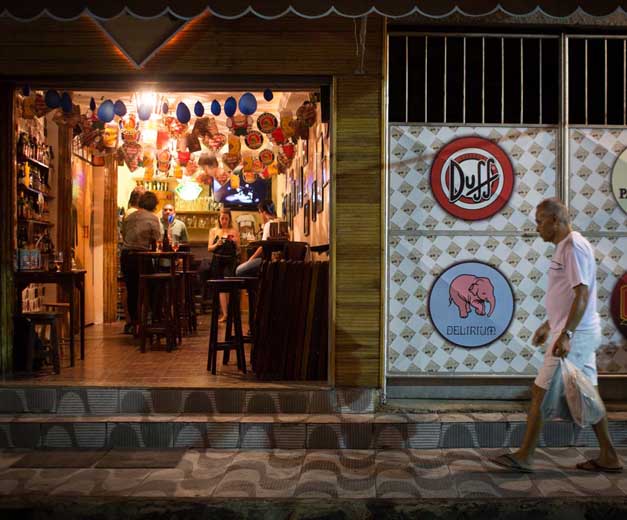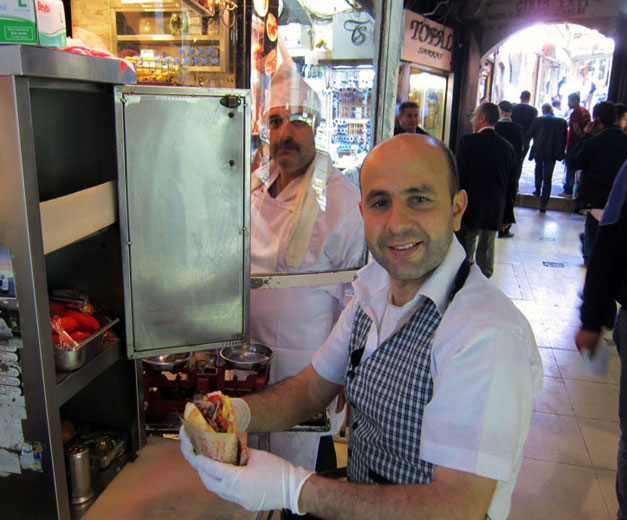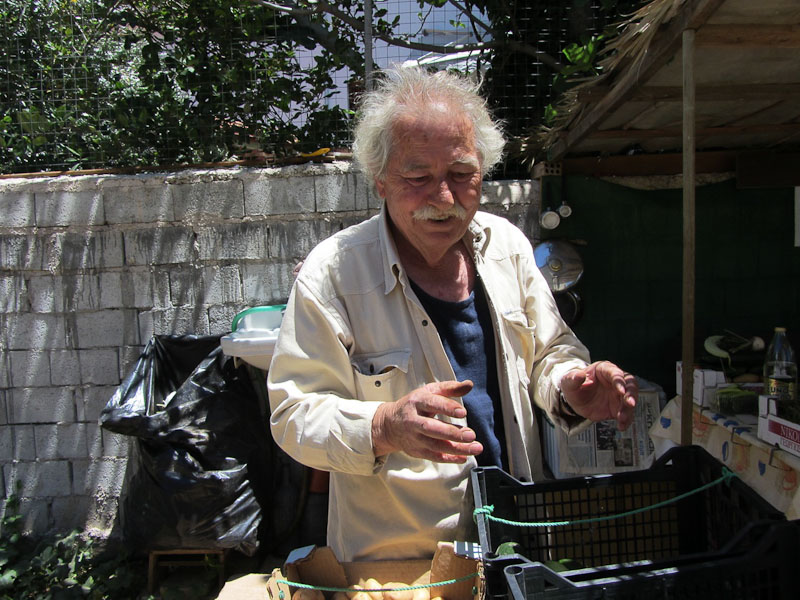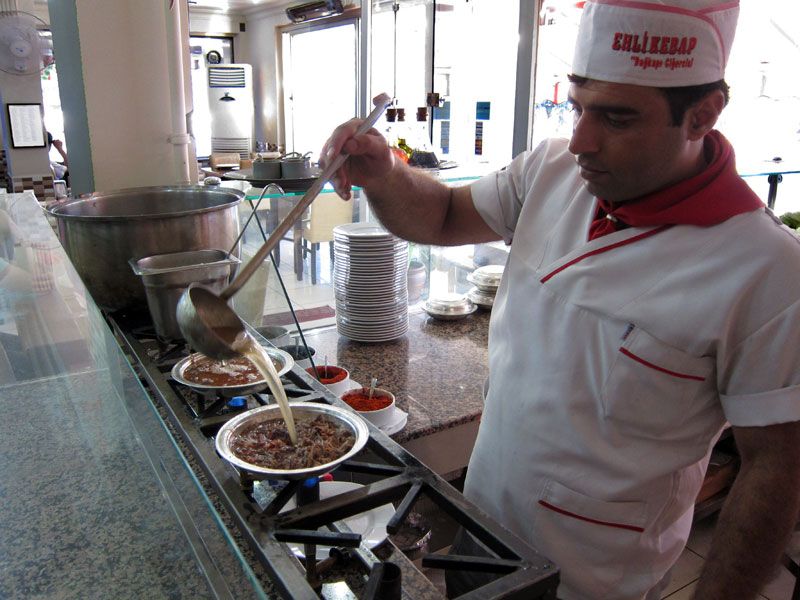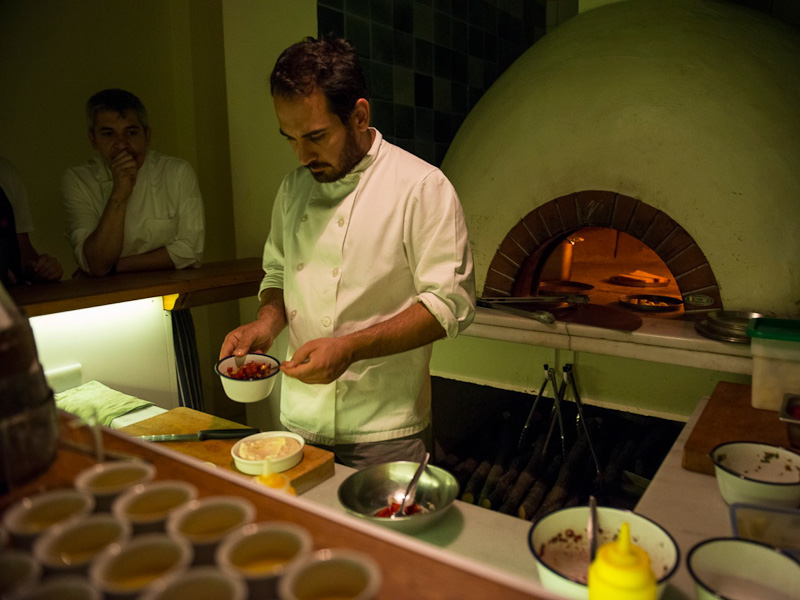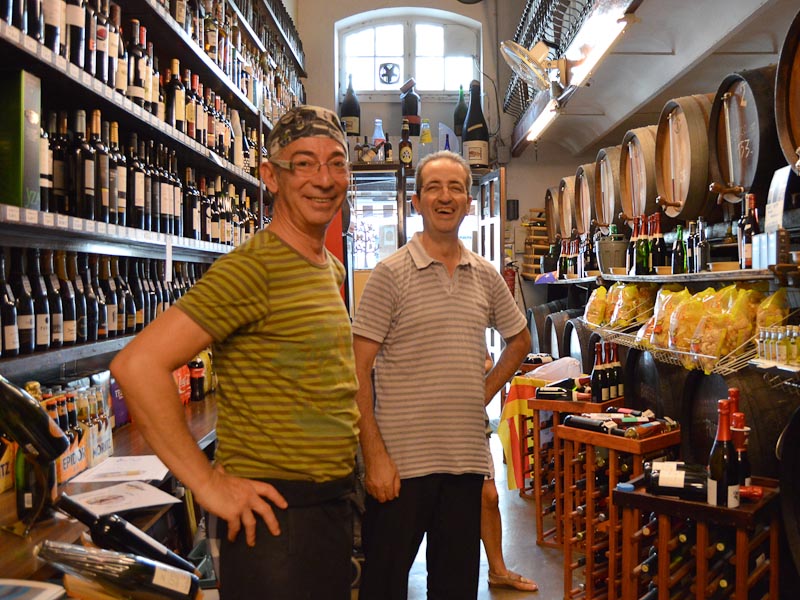We can't find the internet
Attempting to reconnect
Something went wrong!
Hang in there while we get back on track
Search results for
Shanghai
Festive Meals on Wheels: Holiday Delivery Roundup
For expats, the holiday season can be a time of mixed emotions. The distance from home can intensify our feelings of nostalgia (and cravings for Mom’s apple pie). On the other hand, we are liberated from the customs that bind us to familiar feasts, and we have the freedom to form new holiday rituals with friends.
Read moreBarcelona
El Tossal: Down from the Mountains
Now that ski season has begun in Catalonia, thousands of Barcelonans make the pilgrimage every weekend to the Pyrenees. But winter sports are not the only draw; this is also the time to enjoy the cooking at masias, traditional farm buildings that have been converted into restaurants.There, the smells of winter stews and dishes made with mushrooms, game, mongetes (beans) and butifarra (a kind of pork sausage) are motivation enough to arrive at the village early and in one piece.
Read moreMexico City
Mercado San Cosme: Treasure Trove
Whenever we explore a neighborhood in the city, we look for the tianguis: local markets that serve as a very important part of life in Mexico. Almost everything needed for a household can be found in their narrow and colorful aisles. Mercado San Cosme is the tianguis in Colonia San Rafael, a beautiful and charming neighborhood that was established in the late 19th century as one of the first formal communities outside of the city center. In the Porfirio Díaz era, San Rafael catered to the wealthy, and the beautiful buildings and façades that still grace the streets there speak to those long-ago days of glory.
Read moreIstanbul
Salep: Pure and Uncut
When we last visited Cemal Bey, he was sitting behind a desk in a small, bare office on the second floor of a decrepit building near the Egyptian Bazaar in the city’s old quarter (he has since moved). Three large burlap sacks filled with what look like jumbo-sized yellow raisins are all that adorn the room. That and a fax machine. The window behind him frames one of Istanbul’s many transfixing cityscapes – the Golden Horn stretching out under the Galata Bridge where it meets the Bosphorus and the Marmara Sea, departing ferries churning the water white – but Cemal keeps his eye on a fax that’s coming in.
Read moreAthens
Valentina: From Russia with Love
As the weather gets colder and the nights longer, we seek out food that will warm us from the inside out. Although the usual comfort food we enjoy is souvlaki, there are times when warming food from a colder clime is just what we need. And that’s when we head to Valentina.
Read moreIstanbul
İstiridye Balık Lokantası: The Business of Lunch
Editor’s note: We regret to report that İstiridye Balık Lokantası has closed. These days, writing about Istanbul’s old-school restaurants can be heartbreaking work. No sooner do we find out about a classic lunch spot than it turns out the place is about to be closed down to make way for yet another development project. Meanwhile, Istanbul’s relentless drive to modernize and “clean up” its streets has meant there is less and less room for traditional food vendors to operate. We weren’t surprised to learn that one of our favorite street food sellers, the bespectacled man who provided freshly peeled cucumbers by the Galata Tower, recently gave up his iconic perch after being relentlessly squeezed by the municipal authorities.
Read moreBarcelona
Catalonia's White Wines: The Whole Spectrum
When we think of white wine in Catalonia, we think of its seemingly endless possibilities. Production of whites here has a 2,000-year-old history. The wide-ranging diversity in the area’s Mediterranean climate and calcareous soils, from the mountains to the sea, and the combination of old grape varieties and newly introduced “foreigners” with traditional and experimental methods of production make for innumerable styles and no taboos. Who knew white was a color with so many variations? The traditional Catalan grape varieties used to make white wine are mainly macabeo, xarel-lo, parellada and garnatxa blanca, but this area of Spain has the largest number of white grapes included in all its protected appellations (D.O.). Where other Spanish D.O.s usually are deeply defined by one or a few varieties, in the Catalunya D.O. there are more than 16 allowed – 35 counting the reds. In fact, this umbrella appellation, which covers wines that do not fall under the 10 subregion designations (Montsant, Penedès, etc.), was created to allow the use of all the grapes of the other Catalan designations in the entire area. It implicitly gives freedom to Catalan winemakers to express more than the old narrower conceptions of terroir and opens the doors to experimentation.
Read moreAthens
All Natural: A Shopper's Guide to Greek Wild Herbs
We’ve talked before about Greek coffee, and it’s true that going out for coffee is one of Athenians’ favorite pastimes, but there are plenty of Greeks who prefer tea or infusions. And in fact, the practice of gathering wild herbs has a history that stretches all the way back into antiquity. References to Mediterranean flora are found everywhere in history, from Egypt to Asia Minor and from Homer to the ancient Greek philosophers’ texts. Take, for instance, Hippocrates, the so-called father of medicine, who focused on the healing properties of plants and actually recorded about 400 species of herbs and their known uses in the 5th century BCE. That era saw a heavy trade in herbs between the Mediterranean and the East.
Read moreShanghai
Ask CB: Chinese Dining Etiquette?
Dear Culinary Backstreets,I often have to dine with Chinese coworkers at banquets and want to make sure I am not offending anyone. Are there certain dining customs I should adhere to? China’s dining etiquette is more flexible and forgiving than that of other Asian cultures – like Japan, for instance – but there are a few rules you should know. Most are nonverbal cues that demonstrate respect, especially at work or government banquets.
Read moreRio
Sobrenatural: Samba and Seafood
With 4,500 miles of coastline, the world’s largest river by volume (the Amazon), more than 10,000 miles of waterways and the largest amount of fresh water on the planet, Brazil suffers from a certain gastronomical misperception. Yes, this is a country that loves beef, prominently on display in popular Brazilian churrascarias.
Read moreShanghai
Pyongyang: Northern Exposure
North Korean cuisine is about as mysterious as it gets. Few travelers have ever actually been to the reclusive country, and news reports are more often about high-profile rescues and the dire food security situation than its national cuisine. Thanks to 10 North Korean restaurants in Beijing and 50 others scattered around Southeast Asia, those living in the Far East have plenty of opportunity to glimpse the country’s dining scene. Shanghai is home to seven branches of the Pyongyang restaurant chain, and food is only part of the draw. With a nightly show around 7:30 p.m., the song and dance numbers put on by the double-duty waitresses supposedly allow for a rare glimpse inside the traditional culture.
Read moreAthens
Manas Kouzina Kouzina: Mama's Kitchen (Minus Mama)
Update: This spot is sadly no longer open. At first you’re puzzled. What a strange name. Why not just call it Manas Kouzina, Mother’s Kitchen, and be done with it? Well, like everything connected with this new Athenian eatery, which opened at the end of August opposite the big butter-colored church dedicated to St. Irene (Agia Eirini) on Aiolou Street, the name was given tremendous thought.
Read moreIstanbul
Hanegah: Little Fish, Big City
Editor’s note: Sadly, it appears that due to the neighbors no longer wanting to be surrounded by fish fry odors, this restaurant is no longer serving hamsi. We will update if things change. Around the time that hamsi, our favorite little fish, appear in the markets of Istanbul in late fall we become restless for the Black Sea-style cooking we’ve been missing since the previous season. Hamsi (fresh anchovies) are not the only thing to eat in a Black Sea restaurant, but eating in one that doesn’t have hamsi sometimes feels like sitting down for a meal in a BBQ joint that only serves coleslaw.
Read moreRio
Gracioso: Port of Call
Rio’s Port Zone is undergoing a major facelift, and whether that will nicely polish its tired face or look like a botched Botox job remains to be seen. The port is the heart of Rio Antigo and particularly central to Afro-Brazilian history.It’s home to Rio’s first favela (squatter settlement), called Providência, which was originally populated in 1897 by veterans of the War of Canudos who were told the government would provide housing when they returned to Rio and found those promises to be delayed and elusive. At this port, up to an estimated half million slaves walked in from Brazil’s shores to then be sold in the port’s slave market, treated in a hospital if they were sick or buried if they died after arrival in Gamboa, where a fascinating makeshift museum called the Cemitério dos Pretos Novos offers a view of the human bones a homeowner found while digging on her property.
Read moreIstanbul
Asuman: East of the Border
Editor's note: Culinary Backstreets' Migrant Kitchen: Taste of Iran event took place in Istanbul on Monday, and to mark the occasion, we're featuring this review of one of Istanbul's few Iranian restaurants. Considering the fact that Iran is a next-door neighbor to Turkey and that so many Iranians call Istanbul home, we’ve always found it more than a bit baffling that there are hardly any Iranian restaurants in the city. Imagine New York with all but a handful of Mexican restaurants? The one Iranian restaurant in town that we did know about – a tourist-oriented place with an in-house musician who played “Hava Nagila” on his zither – mercifully closed down years ago.
Read moreShanghai
Roast Duck: Chopstick Lickin' Good
The Chinese have appreciated the finer qualities of roast duck for millennia, and in that time, they’ve refined their cooking techniques into a virtual art form. The first mention of roast duck (烤鸭, kǎoyā) dates back to the Northern and Southern dynasties (A.D. 420–589). By the Yuan Dynasty (1206-1368), the tawny bird was gracing the tables of mandarins and emperors in then-capital Nanjing, and imperial kitchen inspector Hu Sihui mentioned it in The Complete Recipes for Dishes and Beverages, published in 1330, along with a record of how the duck was cooked.
Read moreAthens
Taxidevontas: Fisherman's Friend
In Piraeus there is a tacit agreement among locals to keep treasured taverns and restaurants hidden, lest they be overrun by the tourists arriving on the cruise ships that dock in town. This is particularly true of Keratsini, a neighborhood on the outskirts of the port city. In 1922, Keratsini became home to Greek refugees driven out of Smyrna, the coast of the Sea of Marmara and Constantinople during fighting between Greece and the nascent Turkish state. At first, these immigrants were treated poorly and suffered poverty and hardships, but eventually they became a vital part of the Greek population.
Read moreBarcelona
Taverna Can Roca: Gustatory Eye Openers
Editor’s note: We regret to report that Taverna Can Roca has closed. In the neighborhood of Sant Andreu we encounter very few city visitors wandering the cobbled streets or peering at the 19th-century two-story houses that pepper this district. Through the doors of Taverna Can Roca, we find even fewer. This is a place that can be considered muy del barrio.
Read moreShanghai
A Po's Cong You Bing: Afternoon Delight
Here at CB Shanghai, we’ve already confessed our undying affection for the scallion oil pancakes (葱油饼, cōngyóubǐng) at A Da. Mr. Wu’s are so beautifully crafted that they take on the aura of art with their precision and flair, but we’re also a little in love with the slapdash, unconventional version fried up by an elderly couple at A Po, just a couple of blocks away.
Read moreIstanbul
Hamsi: Every Which Way
As a chill sets in and heavy clouds roll over Istanbul, turning the Bosphorus battleship gray, we say goodbye to the luscious strawberries and blood-red tomatoes in the market. Fall marks the start of hamsi season, a time when small anchovies fill the nets of fishing boats on the Black Sea coast, squirming their way – with all of the country’s anticipation – onto grills and into pans and ovens throughout Turkey. The colder and rainier it gets, the fatter and cheaper the hamsi become.
Read moreAthens
New Wave Retsina: A Maligned Wine's Comeback
For too long retsina has been thought of as a cheap, oxidized, overly pungent bad wine made from mediocre grapes, its poor quality disguised by an overdose of resin and exacerbated by being stored in questionable conditions in the backyards of seaside tavernas. To say the wine has an image problem is an understatement – but that may be changing. Regardless of its reputation, retsina is a true Greek original. It dates back to the Ancient Greeks, who would coat the interiors of their otherwise porous earthenware amphorae with resin to make their wine storage airtight. Wine drinkers grew to like the taste, and winemakers consequently began adding pine resin to grape must during fermentation.
Read moreShanghai
Lao Shaoxing Doujiang: All-Night Breakfast
In Shanghai, a pretty surefire way to tell whether a dining establishment deserves your attention or not is by the presence of a line in front of it. (A corollary might be that the amount of attention the place deserves is commensurate with the size of the line.) Lao Shaoxing Doujiang passes the test. This ramshackle stand in the Huangpu district serves traditional breakfast foods all night long. Until recently, the stand was run by a granny in her nineties who would ladle out bowls of hot soy milk (豆浆, dòujiāng) into the wee hours of the morning. She retired this year, but her less-than-friendly son has taken over, and the buzz remains (as does the inevitable line).
Read moreMexico City
La Ciénaga: From South of the Border
Immigration between the U.S. and Mexico has long been thought of as a one-way phenomenon, but global economic upheaval and other factors have made the neighbor to the south the new Land of Opportunity. As a recent New York Times article put it, for the first time “more Americans have been added to the population of Mexico over the past few years than Mexicans have been added to the population of the United States.” Nowhere is this more apparent than in Mexico City, where immigrants come not just from the U.S. or other parts of Mexico, but also Argentina, Spain, Korea – everywhere, really. And these immigrants have brought with them a new world of excellent dining options.
Read moreIstanbul
Can Ciğer: For the Liver Lover in You
Editor's Note: Unfortunately, this spot is no longer open. We’ve written previously about Turkey’s passionate love affair with liver, one that can turn downright obsessive in some parts of the country. Edirne, an old Ottoman capital city about two hours out of Istanbul, is one of those places. Filled with restaurants selling the dish and nothing but, Edirne is perhaps ground zero for Turkish liver lovers. If the city’s countless liver restaurateurs had their way, Edirne’s official symbol would probably be the organ, with a giant, quivering liver sculpture greeting hungry travelers at the entrance to town. Of course, that kind of boosterism is unnecessary; for many Turks, the name Edirne is simply synonymous with liver.
Read moreBarcelona
La Pepita: The Barcelona Globetrotters
We’ve written a great deal about all thetraditionalCatalan, Basque and Spanish food around town, but what about the modern, globally influenced cooking that’s taken hold in the food capitals of the world – of which Barcelona is certainly one? La Pepita is a prime specimen, with its passionate, creative young owners and food that, while anchored in the tapas tradition, reinterprets classic dishes through the cross-pollination of other cultures’ ingredients and ideas.
Read moreAthens
Alexandria: Princess of Egypt
When the aptly named Cleopatra Theodoulou opened her restaurant, Alexandria, in the downtown Mouseio district in 1999, she not only helped in the revival of a once posh neighborhood that had fallen on hard times – she also created a vibrant culinary link to her family’s cosmopolitan past.
Read moreRio
Bistrô Estação R&R: Drink and Thrive
Favelas just aren’t what they used to be – or what you thought they were. Rio’s squatter settlements have grown up, though uneven development still leaves considerable gaps in terms of policing, sanitation, sewage and public services. But the favela label is increasingly arbitrary as Rio’s “slums” – we put that in quotes because we think that word often leads to some generous and inaccurate flights of imagination – start to look more like working-class bairros. And they’re working their way up to becoming the more intriguing and inviting parts of the carioca landscape.
Read moreMexico City
Pulque: A Strange Brew's Revival
Milky, tart, viscous and slightly foamy. At first glance and sip, there’s little to explain why pulque – a mildly alcoholic drink made by fermenting the fresh sap of certain types of maguey, the same plant used for making mezcal – has remained a trusted companion to Mexican drinkers since Aztec times. Pulque, actually, has not only survived, but, after decades of losing ground to beer and soft drinks and their high-priced marketing campaigns, this workingman’s brew is making a comeback. New pulquerías are popping up in hip Mexico City neighborhoods and attracting a younger crowd while old pulquerías, which endured some lean times, are seeing an influx of new customers, who now sit side-by-side with older generations of loyal pulque drinkers. Nobody really seems to know why the previously unheralded nectar has been getting this much attention in the last few years, but several places around town have been capitalizing on this new trend with great success.
Read moreIstanbul
Gülebru Kantin: Döner Redemption
We generally regard the Grand Bazaar as a place of punishment, a den of aggressive, wolf-like hustlers and innocent, lamb-like tourists wearing novelty fez hats. When we have to go, we like to think of ourselves as members of a prison SWAT team, sent in to search a cell for some specific item – Turkmen jewelry, hamam towels and, once, wedding rings.
Read moreAthens
ENOA: (Not) For Members Only
Editor's note: We're sorry to report that ENOA has closed. Situated by the sea in the marina of Agios Kosmas, ENOA is part of a truly strange neighborhood. There are a couple of nightclubs, some cottages and the enormous, badly lit rowing and sailing buildings that have been left to molder after the 2004 Olympics – but mostly the feeling is of an abandoned wasteland by the sea. The entrance to ENOA, an area club, is equally unimpressive: a number of trophies cramped behind a glass display followed by a cavernous dining room that, with its harsh, unflattering neon lights, resembles a hotel from 1960s rural Greece.
Read moreBarcelona
Capped: Catalonia's Magic Mushroom Season
Mushroom hunting has an irresistible, magical pull. Composer John Cage, an avid mushroom collector, found them an integral part of his creative process, once writing: “Much can be learned about music by devoting oneself to the mushroom.” Every fall, thousands of Catalans likewise find themselves under the mushroom’s spell, following the elusive fungus’s silent melody into the woods, a rustic wicker basket in one hand and – more and more these days – a GPS-enabled smartphone in the other.
Read moreIstanbul
In Istanbul, Making the Case for a Slow Fish Movement
Situated on a geographically blessed spot where the waters of the Black Sea and the Sea of Marmara meet, Istanbul has long been associated with fishing and, especially, the eating of fish. In culinary terms, after all, is there anything more iconic in Istanbul than eating a freshly grilled fish sandwich sold from one of the bobbing boats down by the Golden Horn?
Read moreMexico City
Spice Everywhere: Brunch, from North of the Border
Editor’s note: We regret to report that Spice Everywhere has closed. It didn’t take long after arriving from Chicago a decade ago for Juliet Lambert to figure out what was the gaping hole in Mexico City’s otherwise rich culinary scene: an American-style brunch spot. The chef went on to start Spice, a catering company, but earlier this year was able to come up with the answer to the brunch problem when she launched Spice Everywhere, a roving pop-up that is bringing hashbrowns and waffles to the land of the tortilla.
Read moreBarcelona
Bodega Manolo: More than Meets the Eye
At first glance, Bodega Manolo seems like the usual wine shop/tapas bar that Barcelona does so well: a solid place to replenish our wine stocks from the barrels, quench our thirst with a cold caña or satisfy our hunger pangs with a vermut and a tapa or two of oil-drenched anchovies. None of which sound too shabby. However, we know to venture through to the rear, where, at dinnertime, the brilliant white tablecloths reveal the venue’s greater ambitions.
Read moreMexico City
El Parrillón: Gaucho Tacos
Tacos are everywhere in Mexico City, and though the options are many – chicken, al pastor, carnitas, carne asada – the basic ingredients tend to be the same wherever you go. That’s why, as we were walking the aisles of Tianguis La Raza on a Sunday morning, El Parrillón caught our attention.
Read moreAthens
How Petros's Gardens Grow
I’m sitting in the shade of a gardener’s shack with a mad man. At least, that’s what he says he is, though his cloud of white hair, smiling face and cordial manner are reassuringly benign. The garden itself is an ebullience of tomatoes, potatoes, zukes, cukes and eggplant and is especially unusual in Kifisia, the affluent suburb north of Athens, where lawns are prized as a status symbol.
Read moreShanghai
CB on the Road: Chengdu's Spicy Noodles
It’s been two weeks of cycling through China’s Qinghai province, and the food selection is slim. The majority of the province sits on the vast Tibetan Plateau, well above the tree line in conditions too harsh for significant cultivation. Yaks graze on well-trampled grass as far as the eye can see, with white yurts and colorful prayer flags dotting the hillsides and each summit pass. By Chinese standards, six million inhabitants in the country’s fourth-largest province make Qinghai practically deserted. For long stretches, only nomadic yak herders can be spotted between the tiny villages. Stopping for a roadside lunch in the small, isolated towns inevitably means a bowl of either mutton or yak chopped-noodle soup (羊肉面片, yángròu miàn piàn or 毛牛肉面片, máo niúròu miàn piàn). Served up in a tomato-chili broth, it’s a tasty meal, but repeated daily, it inevitably becomes tiresome. Additional ingredients sometimes includes julienned zucchini or green peppers, depending on the remoteness of the particular town and their staggered vegetable shipments. After just one week, we’re eagerly awaiting more fruitful pastures, and Sichuan province, located just to the east on our route, is a culinary paradise.
Read moreIstanbul
İnebolu Pazarı: Shroomin' à la Turca
“You can eat these raw, efendim!” shouted Aziz Bey to a suspicious woman dressed in a headscarf of sharp geometric designs and a denim duster. “Don’t be scared!” he said, ripping the cap off of a raw kokulu cincire mushroom with his teeth and chewing it in an exaggerated, open-mouthed way to show that there were no tricks. “Mis gibi!” he said, using a phrase that is more frequently printed on laundry detergent bottles or uttered by mothers doting over infants. “Fragrant!” In Turkey, many people assign much of what happens throughout the day to kismet, or fate, but when eating wild mushrooms you might be tempting it. Every year, it seems, local papers report on someone’s demise by mushrooms, which explained why the woman in the duster was reluctant to finish the transaction.
Read moreBarcelona
La Perla de Oro: Tapas with a French Accent
Anouchka hails from Extremadura, land of jamón and some of Spain’s best dry-cured sausages. Julien is French and an expert on wine. Together, the husband and wife run La Perla de Oro (“The Gold Pearl”), a pint-sized former colmado (old-style grocery) just off Las Ramblas, where top-notch bocadillos, or baguette sandwiches, are just one of many attractions. Since opening in 1939, three generations at La Perla have supplied their Raval neighbors with cured sausages, cheeses, preserved foods, salted fish and dried legumes. They became known especially for their bocadillos.
Read moreMexico City
Comichurros & Empanadas: Deep-Fryer Superheroes
Update: This spot is sadly no longer open. On a quiet street in Cuauhtémoc, just blocks away from some of Mexico City’s most recognizable landmarks, a slick, colorful sign and unusual name – Comichurros & Empanadas – call out loudly for attention. Inside, the place buzzes with youthful energy and social media and branding savvy: the walls are boldly decorated with floor-to-ceiling drawings of superheroes, onomatopoeic sound effects both old and new (“BAM! THWOK! CHURROS!”) and signs offering customers free churros in exchange for likes, check-ins and tweets. This is an eatery for the 21st century.
Read moreShanghai
Dunhuang Xiaoting: Silk Road Rest Stop
At the dusty eastern edge of the Taklamakan Desert, the ancient city of Dunhuang marked the intersection of the northern and southern parts of the Silk Road. Meaning “Bright Beacon,” Dunhuang was a historical refuge for weary travelers peddling their wares along the trade route, and this confluence of cultures influenced the ancient city’s cuisine. Merchants brought spices and cooking techniques from the West that combined with Chinese imperial culinary traditions and local ingredients.
Read moreBarcelona
Catalonia’s Red Wines: Stairway to Heaven
Legend has it that in 12th-century Priorat, in the region of Tarragona in southern Catalonia, there was a shepherd who dreamt every night of a ladder leaning against a pine tree. The ladder ascended from the valley all the way to heaven and angels climbed up and down, tending to their heavenly and earthly duties. Some Cistercian monks, upon hearing this story, took the vision as a divine message to build the monastery Scala Dei (“Ladder of God”) in that very spot. Those clever monks, noting the angels’ comings and goings, decided to become their wine suppliers and began cultivating grapes and making wine there.
Read moreIstanbul
Ehli Kebap: Slurper’s Delight
Southeastern Turkey’s culinary mecca of Gaziantep is best known for its baklava and kebabs. But lately we’ve been thinking that it's soup that may actually be the city’s real crowning glory. Not just any old soup, mind you, but beyran çorbası, a stupendously delicious lamb-based broth that is usually slurped down for breakfast in Gaziantep.
Read moreAthens
Pnyka: The Bread Evangelists
Dimitris Kotsaris was more proselytizer than baker. Rather than a flour-dusted apron, this mild-mannered gentleman would wear elegant suits to meet with journalists, bearing two or three kilos of his famous whole-wheat bread as a gift. He was an ardent believer in the medicinal qualities of bread and preached widely that good bread promoted good health, once even taking his case to Harvard, where he delivered a talk about the role of well-made loaves in healthy diets. In 1981 Kotsaris opened Pnyka, the pulpit from which he spread his yeasty gospel, and gave the bakery the Greek name for the hill downtown where, in the golden years of Ancient Greece, Athenians gathered for the general assemblies that played such a formative part in the creation of democracy. It is quite fitting then that the first Pnyka shop opened in Syntagma (“Constitution”) Square. The bakery has since added two more shops in the city, in Exarchia and in Pagrati, the headquarters of the operation, and its following is such that last year a third was established in Vienna. Kotsaris passed away last year but his vision lives on through his son George, who has taken over the business.
Read moreShanghai
Assessing the State of the Mooncake
Shanghai’s hottest summer on record is officially behind us, which can mean only one thing: Mid-Autumn Festival is just around the corner. Zhōngqiū jié (中秋节) is that memorable time of year when Chinese people gift (and regift) bite-sized treats known as mooncakes (月饼, yuèbǐng).
Read moreIstanbul
Yeni Lokanta: Old-School Ingredients, New-School Taste
It is puzzling that Istanbul, a city of some 15 million people with an increasingly lavish lifestyle, a world-famous cuisine and a booming tourism industry, has so little sparkle when it comes to fine dining. We’re surprised that the Prime Minister himself has not jumped into the culinary scrum by demanding no fewer than three Michelin stars from every restaurant. The city still has yet to answer with one.
Read moreBarcelona
La Pubilla del Taulat: Mix and Match
Update: This spot is sadly no longer open. The bodega side of La Pubilla del Taulat’s split-personality operation is no ordinary wine shop. While one wall is lined with hundreds of bottles from all over Spain, it’s the wall opposite that commands attention, with its row of massive casks. After nearly disappearing over the last few decades, bulk wine is back. And though customers these days are more likely to tote their wine home in big plastic jugs, the garrafa, the straw-covered flask of old, is making a comeback too. Besides the cheap tariff, there’s another upside to buying wines in bulk: custom wine blending, straight from the cask.
Read more


